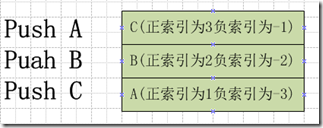lua与CAPI概述
1. 栈
1.1 说明
lua与C语言操作都是通过栈来进行的。这个栈是抽象的栈,栈中每一个元素都能保存任何类型的LUA值。
要获得一个lua中的一个值时(例如一个全局变量),只要调用一个Lua的Api函数,Lua就会将指定的值压入栈中。
要将一个值传入Lua时,需要先将这个值压入栈,然后再调用Lua Api,Lua就会获取值并将此值从栈中弹出。
几乎所有的lua api都会使用到栈,luaL_loadbuffer将它的结果(编译好的程序或错误消息)留在栈中;lua_pcall会调用栈中的一个函数,若发生错误则将错误信息留在栈中。
1.2 栈的索引与查询元素
以栈底为参考物:api使用“索引”来引用栈中的元素。第一个压入栈中的元素索引为1;第二个压入的元素索引为2依此类推。
以栈顶为参考物:使用负数的索引来访问栈中的元素。此时,-1表示栈顶元素(最后一个压入的元素),-2表示栈顶下面的一个,依此类推。
代码测试
int _tmain(int argc, _TCHAR* argv[]) { lua_State *L = luaL_newstate(); luaL_openlibs(L); lua_pushstring(L,"this is a"); lua_pushstring(L,"this is b"); lua_pushstring(L,"this is c"); cout<<lua_tostring(L,1)<<endl; cout<<lua_tostring(L,2)<<endl; cout<<lua_tostring(L,3)<<endl; cout<<"---------------"<<endl; cout<<lua_tostring(L,-1)<<endl; cout<<lua_tostring(L,-2)<<endl; cout<<lua_tostring(L,-3)<<endl; lua_close(L); system("pause"); return 0; }
以上代码的输出结果为:
this is a
this is b
this is c
---------------
this is c
this is b
this is a
请按任意键继续. . .
为了检查一个元素是否为特定类型,API提供了类似lua_is*的函数,例如lua_isnumber等。实际上lua_isnumber不会检查值是否为数字类别,而是检查能否转换为数字类型
lua_tolstring返回的字符串在其末尾会有一个额外的零,不过这些字符串中间也可能有零,字条串长度通过第三个参数len返回,这才是真正的字符串长度。尽管下总为真
size_t l; const char* s = lua_tolstring(L,-1,&l); assert(s[l] == '\0'); assert(strlen(s) <= 1)
因此遍历栈有以下方法
//遍历栈 static void statckDump(lua_State * L) { int nTop = lua_gettop(L); for(int i = 1;i <= nTop;i++ ) { int t = lua_type(L,i); switch(t) { case LUA_TSTRING: printf(" '%s' ",lua_tostring(L,i)); break; case LUA_TBOOLEAN: printf(lua_toboolean(L,i) ? "true" : "false"); case LUA_TNUMBER: printf("%g",lua_tonumber(L,i)); break; default: printf("%s",lua_typename(L,t)); break; } printf(" "); } printf("\n"); }
1.2 其它栈操作
int lua_gettop(lua_State * L)
返回栈中元素的个数,也可以说是栈顶元素的索引。int lua_settop(lua_State * L ,int index)
将栈顶设置为一个指定的位置,即修改元素数量。如果之前的栈比新设置的要高,那么高出来的那些会被丢弃。反之,会向栈中压入nil来补足大小。有一个特例,调用lua_settop(L,0)能清空栈。也可以用负数索引来使用lua_settop。另外,API根据这个函数还提供了一个宏,用于从栈中弹出n个元素。
#define lua_pop(L,n) lua_settop(L,-(n)-1)lua_pushvalue函数会将指定索引上的值 的副本压入栈。lua_remove删除指定索引上的元素,并将该位置之上的所有元素下移以填补空缺。
lua_insert 会上移指定位置之上的所有元素以开辟一个槽的空间。然后将栈顶元素移动到该位置。
lua_replace弹出栈顶的值,并将该值 设置到指定索引上。但它不会移动任何东西。
int _tmain(int argc, _TCHAR* argv[]) { lua_State * L = luaL_newstate(); lua_pushboolean(L,1); lua_pushnumber(L,10); lua_pushnil(L); lua_pushstring(L,"hello"); statckDump(L); lua_pushvalue(L,-4);//将指定索引值压入副本 statckDump(L); lua_replace(L,3); //弹出栈顶值 并把索引为3的元素替换 statckDump(L); lua_settop(L,6); //增高栈顶 statckDump(L); lua_remove(L,-3); //移除索引为-3 statckDump(L); lua_settop(L,-5); statckDump(L); lua_close(L); system("pause"); return 0; }
输出结果为:
true 10 nil 'hello'
true 10 nil 'hello' true
true 10 true 'hello'
true 10 true 'hello' nil nil
true 10 true nil nil
true
请按任意键继续. . .
最后说一下lua_pop
lua_pop(lua_State * L,int number);
此函数是从栈中弹出 number个元素,而不是弹出第number的元素




